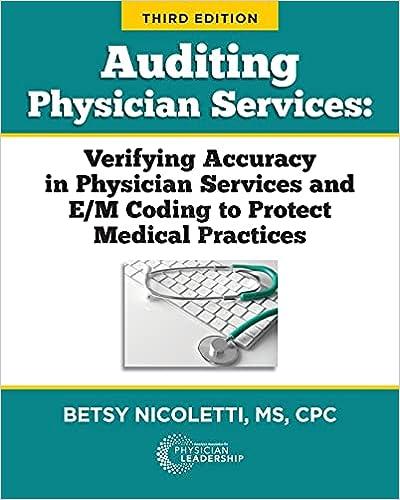Question
Please answer all: 1. Presented below is the income statement for Anderson Inc. for the month of May: Sales $1,280,000 Cost of goods sold 1,180,000
Please answer all:
1. Presented below is the income statement for Anderson Inc. for the month of May:
| Sales | $1,280,000 |
| Cost of goods sold | 1,180,000 |
| Gross profit | $100,000 |
| Operating expenses | 64,000 |
| Operating income | $36,000 |
2. The company's contribution margin ratio is 15% (variable expenses are 85% of sales). (a) Rearrange the above income statement to the contribution margin format remember, sales are 100% of sales, and sales x contribution margin ratio = contribution margin.
(b) Calculate the break-even point in sales revenue.
(c) Calculate the sales revenue needed to generate a target profit of $50,000.
(d) Calculate the margin of safety and margin of safety ratio.
3. . An example of a cost likely to have a mixed behavior pattern is:
A. sales force commission.
B. raw material cost.
C. depreciation of production equipment.
D. electricity cost for the manufacturing plant.
4.. An example of a cost likely to have a fixed behavior pattern is:
A. sales force commission.
B. production labor wages.
C. advertising cost.
D. electricity cost for packaging equipment.
5. An example of a cost that is likely to have a variable behavior pattern is:
A. sales force salaries.
B. depreciation of production equipment.
C. salaries of production supervisors.
D. production labor wages.
6. Which of the following is not true as the total volume of activity changes:
A. the variable cost per unit changes.
B. the total of fixed costs remain the same.
C. variable costs per unit remain the same.
D. the total variable costs changes.
7. The formula for expressing the total of a fixed, variable, or mixed cost at any level of activity is:
A. total cost = fixed cost + (variable rate * volume of activity).
B. total cost = fixed cost * volume of activity.
C. total cost = fixed cost * variable rate.
D. total cost = fixed cost - variable cost.
8. When a cost formula is used to describe a mixed (semi-variable) cost behavior pattern, total fixed costs will remain constant and variable costs per unit are expected to:
A. increase as the level of activity increases.
B. decrease as the level of activity decreases. .
C. decrease as the level of activity increases.
D. remain constant as the level of activity increases.
9. When the cost behavior pattern has been identified as fixed at a certain volume of activity:
A. any change in volume will probably cause the cost to change.
B. it is appropriate to express the cost on a per unit of activity basis.
C. the total cost will not change even if the volume of activity changes substantially.
D. the total cost may change if the volume of activity changes outside of the relevant range.
10. The number of units needed to break even is calculated by dividing the total fixed costs by:
A. Total contribution margin.
B. Contribution margin per unit.
C. Contribution margin ratio.
D. Contribution margin less variable costs.
11. As the level of activity decreases:
A. fixed cost per unit decreases.
B. variable cost per unit decreases.
C. fixed cost remains constant in total.
D. variable cost remains constant in total.
12. XYZ Company has a contribution margin ratio of 60%, fixed expenses of $200,000, and desires to earn operating income of $100,000. Total sales revenue required to achieve XYZ Company's desired operating income is:
A. $340,000.
B. $380,000.
C. $420,000.
D. $500,000.
13. ABC Company's sales are $100,000, fixed costs are $50,000, and variable costs are $30,000. ABC Company's contribution margin and operating income are __________ and __________ respectively.
A. $50,000; $20,000
B. $20,000; $70,000
C. $70,000; $50,000
D. $70,000; $20,000
14. When rearranging a traditional income statement into a contribution margin format, sales revenues _______________ while operating income ______________:
A. Increases, decreases
B. Decreases, increases
C. Both decrease
D. Both stay the same
Kindly answer all.
Step by Step Solution
There are 3 Steps involved in it
Step: 1

Get Instant Access to Expert-Tailored Solutions
See step-by-step solutions with expert insights and AI powered tools for academic success
Step: 2

Step: 3

Ace Your Homework with AI
Get the answers you need in no time with our AI-driven, step-by-step assistance
Get Started


